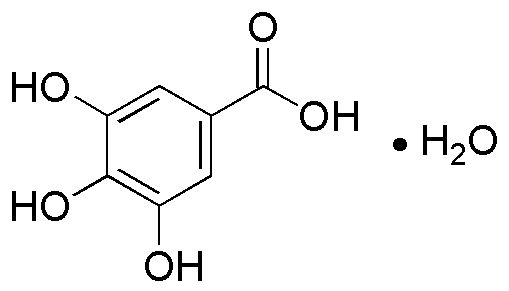Gallic acid monohydrate is widely utilized in research focused on:
- Pharmaceuticals: It serves as an antioxidant and anti-inflammatory agent, making it valuable in the formulation of health supplements and medications aimed at reducing oxidative stress.
- Food Industry: Used as a natural preservative, it helps extend shelf life and maintain the quality of food products by preventing spoilage and oxidation.
- Cosmetics: Its skin-soothing properties make it a popular ingredient in skincare products, helping to reduce irritation and promote a healthier complexion.
- Analytical Chemistry: Gallic acid monohydrate is employed as a standard in various assays, including those measuring antioxidant capacity, due to its well-defined chemical properties.
- Dyes and Pigments: It is used in the production of natural dyes, providing an eco-friendly alternative to synthetic colorants in textiles and other materials.
General Information
Properties
Safety and Regulations
Applications
Gallic acid monohydrate is widely utilized in research focused on:
- Pharmaceuticals: It serves as an antioxidant and anti-inflammatory agent, making it valuable in the formulation of health supplements and medications aimed at reducing oxidative stress.
- Food Industry: Used as a natural preservative, it helps extend shelf life and maintain the quality of food products by preventing spoilage and oxidation.
- Cosmetics: Its skin-soothing properties make it a popular ingredient in skincare products, helping to reduce irritation and promote a healthier complexion.
- Analytical Chemistry: Gallic acid monohydrate is employed as a standard in various assays, including those measuring antioxidant capacity, due to its well-defined chemical properties.
- Dyes and Pigments: It is used in the production of natural dyes, providing an eco-friendly alternative to synthetic colorants in textiles and other materials.
Documents
Safety Data Sheets (SDS)
The SDS provides comprehensive safety information on handling, storage, and disposal of the product.
Product Specification (PS)
The PS provides a comprehensive breakdown of the product’s properties, including chemical composition, physical state, purity, and storage requirements. It also details acceptable quality ranges and the product's intended applications.
Certificates of Analysis (COA)
Search for Certificates of Analysis (COA) by entering the products Lot Number. Lot and Batch Numbers can be found on a product’s label following the words ‘Lot’ or ‘Batch’.
*Catalog Number
*Lot Number
Certificates Of Origin (COO)
This COO confirms the country where the product was manufactured, and also details the materials and components used in it and whether it is derived from natural, synthetic, or other specific sources. This certificate may be required for customs, trade, and regulatory compliance.
*Catalog Number
*Lot Number
Safety Data Sheets (SDS)
The SDS provides comprehensive safety information on handling, storage, and disposal of the product.
DownloadProduct Specification (PS)
The PS provides a comprehensive breakdown of the product’s properties, including chemical composition, physical state, purity, and storage requirements. It also details acceptable quality ranges and the product's intended applications.
DownloadCertificates of Analysis (COA)
Search for Certificates of Analysis (COA) by entering the products Lot Number. Lot and Batch Numbers can be found on a product’s label following the words ‘Lot’ or ‘Batch’.
*Catalog Number
*Lot Number
Certificates Of Origin (COO)
This COO confirms the country where the product was manufactured, and also details the materials and components used in it and whether it is derived from natural, synthetic, or other specific sources. This certificate may be required for customs, trade, and regulatory compliance.


